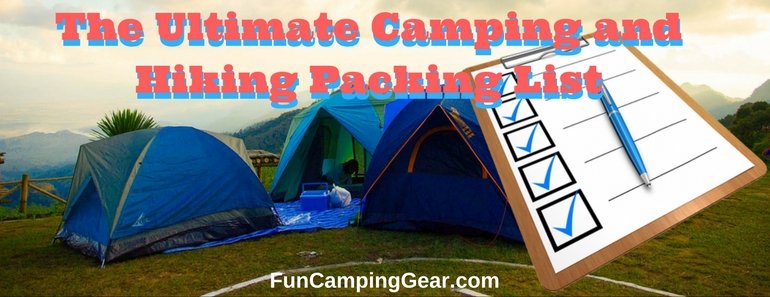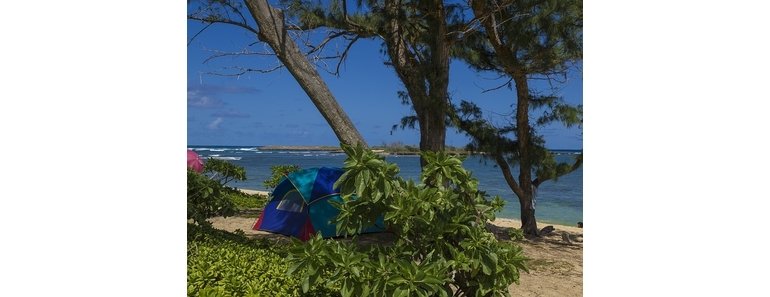A sleeping bag is one of the most important outdoor camping essentials. Its main purpose is to insulate the body and provide comfort, especially in cold weather.
There are many factors to consider when choosing the best sleeping bag for camping. It is easy to make a mistake if you are new to the outdoors. This guide will help you choose the best sleeping bag for your needs. Below is a list of things to consider.
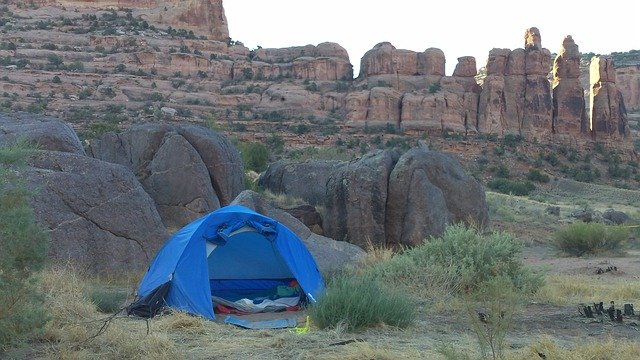
Factors to Consider when choosing a Sleeping Bag for Camping
Temperature Rating
The temperature rating will determine the warmth the sleeping bag will provide under certain temperatures. If a sleeping bag has a temperature rating of 20 degrees, this means that you can stay warm if the temperature doesn’t drop below 20 degrees.
Knowing the environmental conditions at your camping destination will give you an idea about the average temperature. For instance, camping in a warm place by the lake will require a sleeping bag with a higher temperature rating and less insulation. Likewise, if you will be camping in a cold destination like the Alps, it is best to choose a sleeping bag with a lower temperature rating.
It is best to choose a sleeping bag with a temperature rating that is lower than the lowest expected temperature of your destination.
If your body gets cold easily, opt for a sleeping bag with a lower temperature rating than what an average person would likely choose. If you feel too warm, you can always vent the bag for better air circulation. It’s always better to be warm than brave the freezing cold.
Type of Insulation
Type of insulation refers to the materials used to fill the sleeping bags which commonly are synthetic or down feathers from geese or ducks.
There is much debate regarding which of the two is the better option. Below are the pros and cons of each.
Synthetic:
| Pros | Cons |
|---|---|
| Retains insulation even when wet | Doesn’t retain heat well |
| Affordable | Not as durable as down sleeping bags |
| Cleans and dries easily | |
| Best for weekend trips and car camping | |
| Non-allergenic |
Down:
| Pros | Cons |
|---|---|
| Retains heat well | Doesn’t retain insulation when wet |
| Packs small and lightweight | More expensive |
| Durable | Doesn’t clean easily |
Each insulation type has its own pros and cons but choosing between the two will all come down to your budget and the way you camp.
If you have a bigger budget, down is a better choice, especially for a lightweight sleeping bag. Backpackers prefer this option. If you are a seasonal camper, synthetic is a good and affordable option.
Sleeping Bags Shapes:
If your main concern is warmth, this is the best option as it provides less space for the air to move freely. Thus, your body can warm up with the air inside the bag easily. It is safe to say it’s the warmest sleeping bag based on the shape.
It is wide at the shoulders and tapers down to the feet. It is snug and provides less wriggle room making it quite restricting. Yet, this type of bag packs lightly and is highly preferred by backpackers and mountaineers. Most cold weather sleeping bags are mummy-shaped.
The shape of the sleeping bag has a surprising effect in keeping the sleeper warm. Less space inside the bag means less circulating air, thus making and keeping you warm faster. The shape of the bag also determines the moving space inside of it.
There are 3 common shapes of sleeping bags:
Mummy Shaped Sleeping Bag
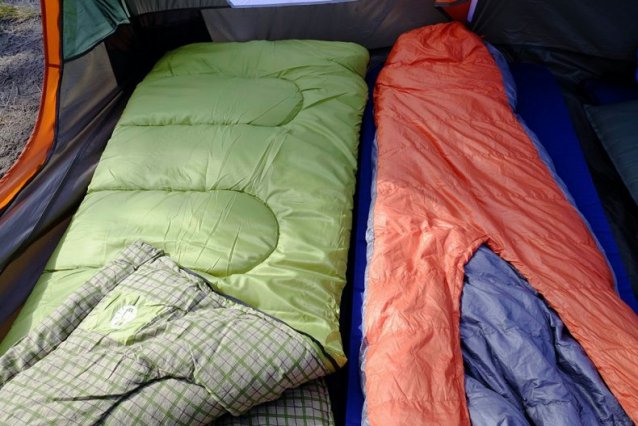
Tapered Rectangular Shaped Bag
Also known as semi-rectangular or barrel shaped bag, this bag is shaped similar to the mummy shaped sleeping bag , only less restricting. It is rectangular at the top part and tapers down to the end of the bag but not as much as the mummy shaped bag. It gets you warm fast and has enough wriggle room for your body to breathe.
Rectangular Shaped Sleeping Bag
Its shape is obviously a rectangle, zippered on both sides (others are not zipped) with plenty of wiggle space. If you are sleeping indoors, in an RV or a car and weight is not a problem, this is a great choice for comfort.
The rectangular shaped sleeping bag is available in single and double sizes. Ideal for multiple sleepers or as a 2 person sleeping bag for couples or campers with a toddler. Two rectangular sleeping bags can be made into roomier zip together sleeping bags for couples and families.
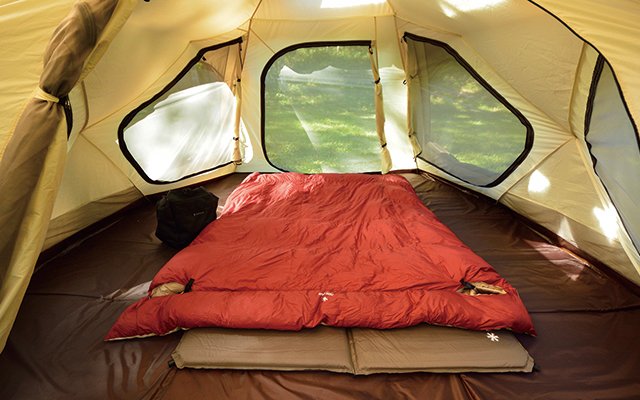
Types of Sleeping Bags
Different seasons for camping means varying temperatures. Sleeping bag types are based on different seasons and each has a corresponding temperature rating.
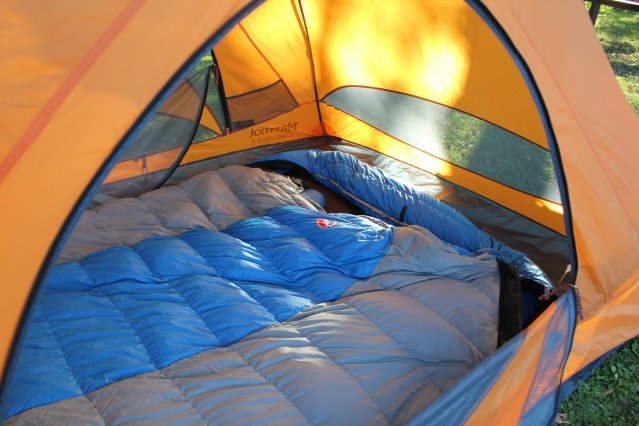
Summer Season Bag Type
As its name suggests, a summer sleeping bag is ideal for summer camping and has a temperature rating of 35 degrees or higher. It is ideal to use this type of bag when you don’t expect the temperature to drop below 30 degrees.
3 or 4-Season Sleeping Bag Type
This type of sleeping bag is the most versatile among all other bag types. Many consider this to be an all-purpose bag for camping during the summer, spring or fall. For people who don’t get cold easily, it can also act as their sleeping bag during the winter season. It usually has a temperature rating between 10 to 35 degrees.
Winter Bag Type
A winter sleeping bag is the best choice for people who camp in cold temperatures or seasons. Its temperature rating is 10 degrees or lower. It is also a better option for people who easily get cold in temperatures between 30-45 degrees.
Other Types of Sleeping Bags:
There are also various types and sizes of sleeping bags for kids, toddlers, girls and women.
Sleeping Bags for Girls or Women
Sleeping bags specific for women are shaped according to their bodies. These are usually shorter compared to standard sleeping bags. They are also wider at the hips to match the contours of a woman’s body.
On average, women easily get cold compared to men thus, these types of bags specific for women have extra insulation.
Kids’ Sleeping Bags
These kinds of bags are tailored for kids’ needs and are slightly different than the average sleeping bags in the market. They have extra features to make your child’s camping experience more comfortable.
Most common models of kiddie sleeping bags have pillow pockets for a more comfortable sleep and external pockets for your young camper’s things like headlamps, phones, mp3s, etc.
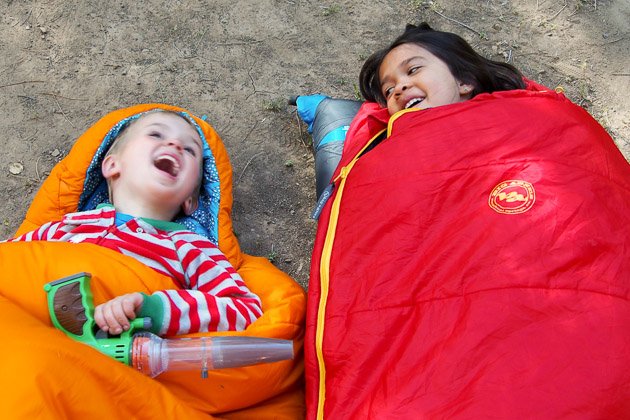
Consideration for Choosing a Baby Sleeping Bag
When choosing a baby sleeping bag, it is best to consider the age of the baby, the material the sleeping bag is made of, the thermal insulation options, and safety features of the baby sleeping bag.
Other Features you May Consider:
In addition to the major features to consider when buying a sleeping bag, there are other features to consider, too. They may not be the main reason for the purchase, but these other features are definitely helpful for your decision making, especially when you’re on the fence in deciding between two of your top choices. These features are as follows:
Lining Material
The lining material of your sleeping bag can affect its comfort and insulation. Materials like polyester or nylon can easily dry up preventing moisture. Cottony materials trap in moisture and tend to dry a lot slower, leaving your bag feeling damp and uncomfortable to sleep in. Trapped-in moisture can also be the cause of foul odor and even irritation when it comes in contact with the skin.
The Hood
Some sleeping bags come with hoods. Having this extra feature won’t hurt. In fact, it can even make your outdoor experience cozier. With a hood, you won’t have to wear a hat or bonnet when sleeping. A hood means extra comfort and protection when using your sleeping bag.
Zippers
Just like the hood, sleeping bags may or may not have zippers. The location and length also varies. If you can check the display, you can try the zippers whether they snag, easily close or open up. Some bags have zippers from top to bottom and open up all the way so they can be converted into blankets. These bags are convenient to use if you need to cool off when you feel too warm.
There are also two-way zippered bags which offer flexibility and ventilation. These types of bags can be zipped together to create a bigger bag if you wish to share sleeping bags with family or loved ones.
Inner Pockets
Inner pockets are also very handy when you have valuable personal items like wallets, jewelry, and phones. The inner pockets of your sleeping bag function as your temporary safe storage when camping.
There are many more extra features a sleeping bag can have depending on its price tag. Your sleeping bag doesn’t need to have all those features. What’s important is that you get the main features that will benefit you the most.
Other Tips for Your Purchase:
- Did you know that a dark colored lining absorbs heat better than light colored lining? This is handy when you want to dry out your sack after a cold, humid night.
- Choose a longer sleeping bag than your average height, at least half a foot of extra space at the base. This extra space is perfect for storage. Extra space in your sleeping bag will also allow you to wear more layers of clothing in case of cold weather.
- Choose a sleeping bag with its zipper on the opposite side of your leading hand. If you are right handed for instance, choosing a bag with the zipper on the left side is more convenient when you unzip it after a good night’s sleep.
How to Store and Care for your Sleeping Bag
Whether you choose a down or synthetic insulation, here are a few tips for maintaining your sleeping bag and keeping it in top condition for your next adventure.
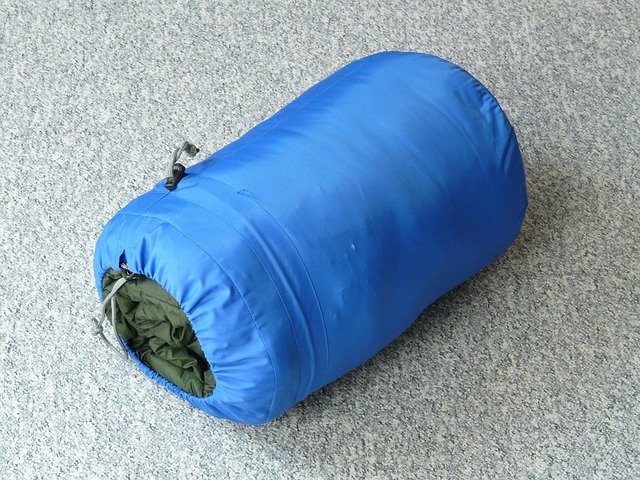
Storing
- After every trip, sleeping bags must be air dried for about 24 hours in a cool place.
- Avoid storing your bag in its own storage sack for long periods of time. The longer the insulation is compressed, the more loft and warmth trapping ability it loses.
- A lot of sleeping bags include a larger storage sack in addition to the small travel stuff sack. Keep your bag inside the larger storage sack. If you don’t have a larger storage sack, opt for an oversized breathable storage bag, or simply use a king sized pillowcase as storage.
- Store it in a cool and dry place.
Washing
- Wash your sleeping bags only when needed. In general, most people consider washing their bags annually. Washing after every trip is not recommended as frequent washing can lower the quality of the insulation’s ability to keep you warm.
- Before washing, repair any tears and use a sew-on patch.
- It is recommended to use a front load, oversized washer. A home washing machine with an agitator can compress and twist the insulation and can cause damage to the sleeping bag.
- To thoroughly remove unpleasant smells and dirt, use the gentle cycle, warm water, and choose a detergent that is specifically made for washing and cleaning synthetic material. However, any mild soap works fine as long as you rinse it off completely.
- Dry cleaning is not recommended because the harsh chemicals will damage the materials.
Drying
- Exercise caution when transferring a wet sleeping bag from the washing machine to the dryer as the fine fibers and stitching are easy to break when wet.
- Choose a large commercial dryer and use the medium heat setting.
- If you are drying a down bag, use some clean tennis balls to help regain its loft.
- It can take some time (from 2 to 5 hours) to dry a sleeping bag completely.
- After drying, unzip it, hang it up and allow it to air dry overnight.
- If sleeping bags are not dried completely, mold and mildew might build up. It is best to inspect the bag carefully before you store it.
- After cleaning and drying your sleeping bag, consider exposing it under the sun as the sun’s UV rays are known to have disinfecting properties.
With so many options available with sleeping bags in the market, it is easy to get overwhelmed. Bear in mind that what you deem are the best criteria based on functionality, durability, price and ease of use.
It’s best to compare products online and start visiting local shops. If you can test a sleeping bag, do it. You are investing good money on it. Take your time before making a purchase.
You don’t need to have the best sleeping bag in the market, but you can definitely have the best sleeping bag that fits your needs.
We did the heavy lifting for you related research and finding the top 5 sleeping bags in the market today. Click here to read the full detailed review.
Sources:
https://www.rei.com/
http://www.mountainwarehouse.com
http://www.dummies.com/
http://www.gocampingaustraliablog.com/


